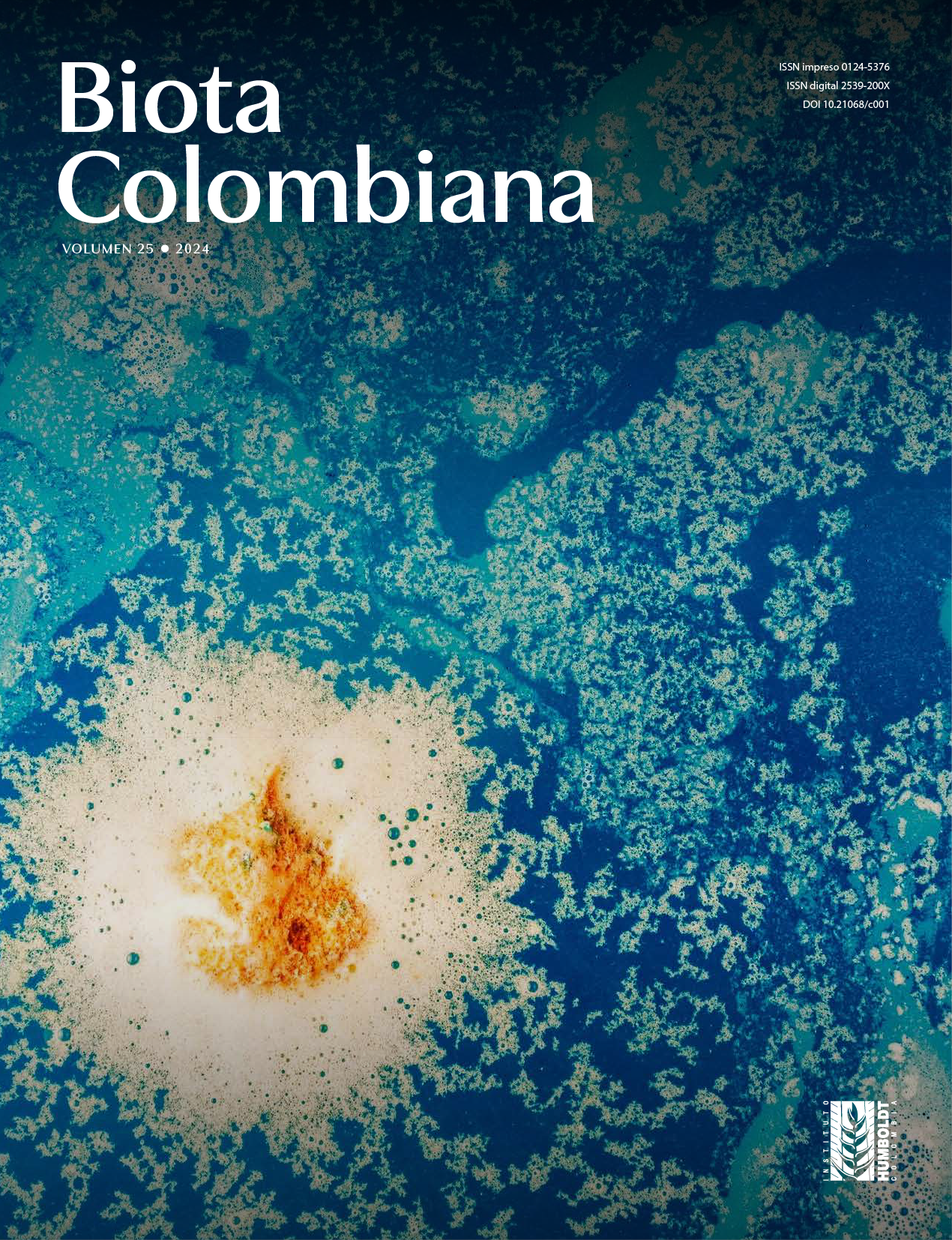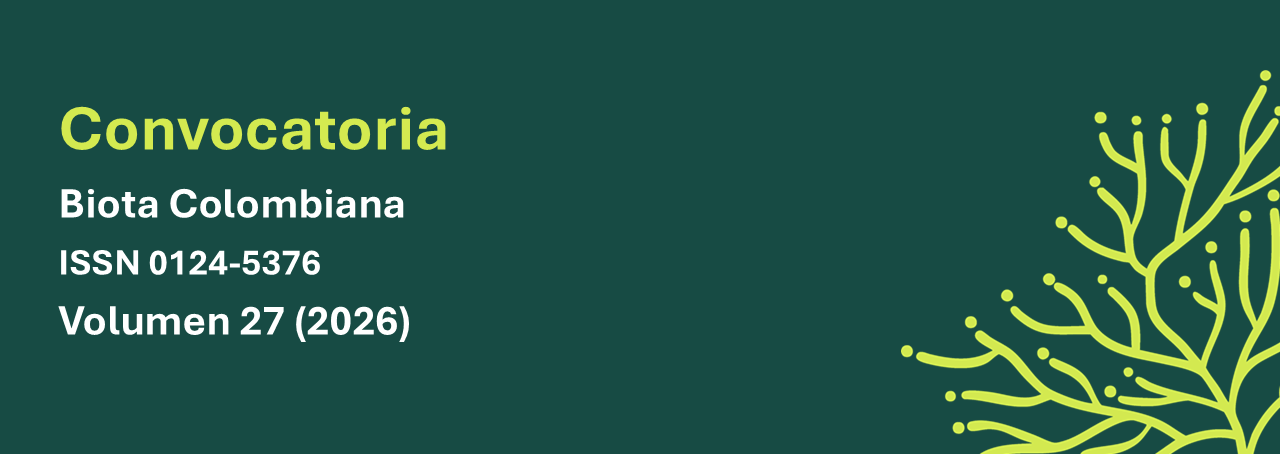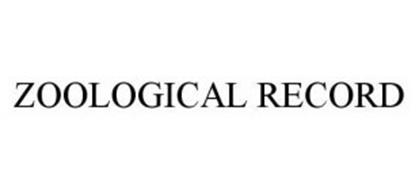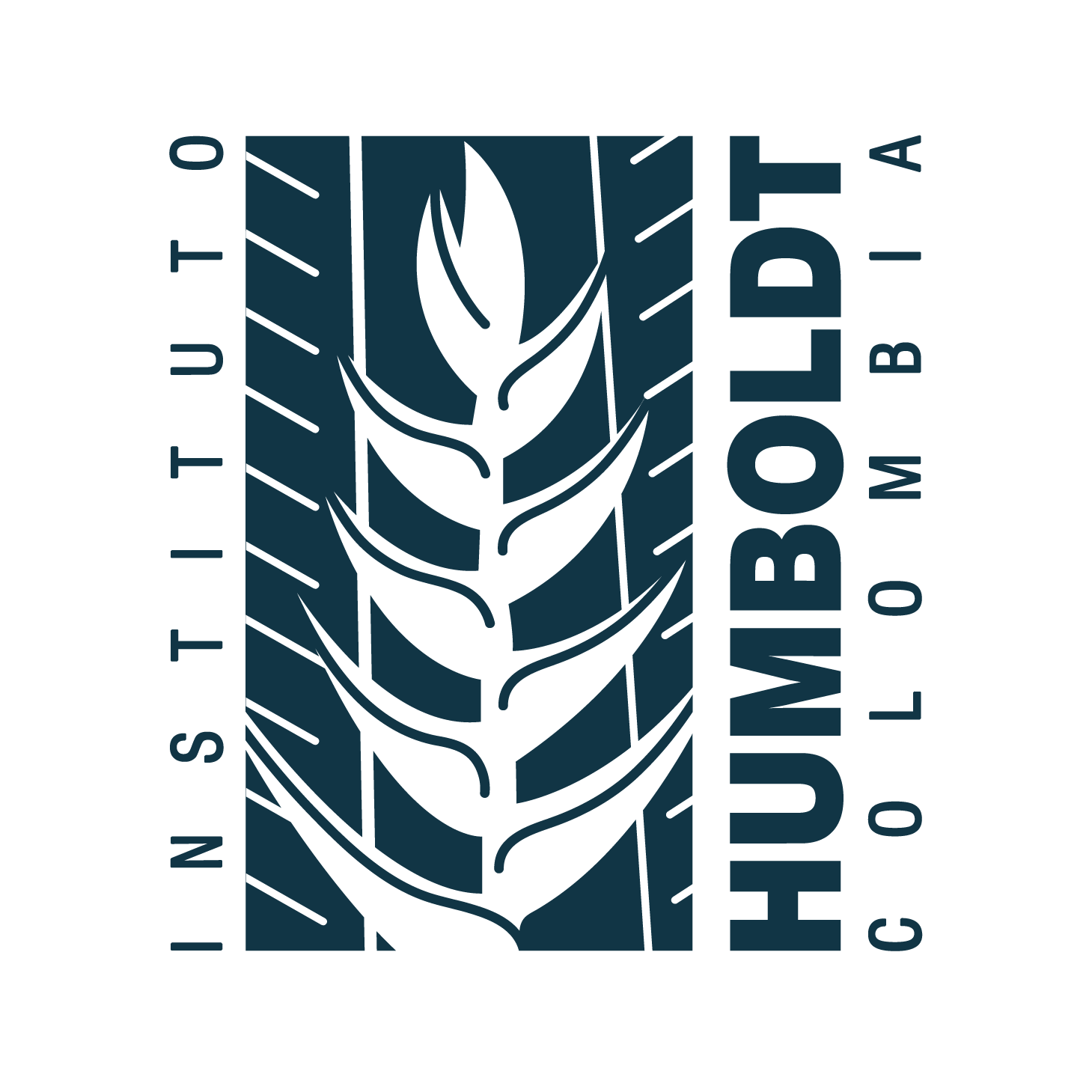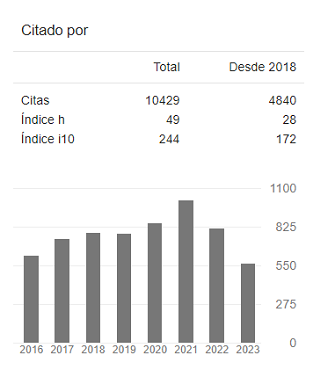Recibido: 13 de junio de 2023; Aceptado: 15 de noviembre de 2023; : 7 de febrero de 2024
Resumen
La serranía de San Lucas (Colombia) se considera de alto valor para la conservación de la biodiversidad, pero poco se sabe sobre su fauna. Entre finales de 2016 (lluvias) e inicios de 2017 (seca) se realizaron dos salidas de campo para caracterizar la fauna de anfibios y estimar su diversidad taxonómica en el río Cimitarra, al sur de esta serranía. Como resultado, se registraron 183 individuos pertenecientes a 23 especies, 15 géneros y 8 familias. Aunque la riqueza no difirió entre temporadas, la diversidad fue casi el doble en temporada seca que en la de lluvia, siendo el bosque natural fragmentado la cobertura más diversa con 14,2 especies (q1). La composición de anfibios fue diferente entre temporadas y coberturas, con altos valores de diversidad β debido principalmente al anidamiento en el ensamblaje. Los anfibios del río Cimitarra muestran un patrón de similitud con otras localidades dependiendo de su distancia geográfica. Estos resultados contribuyen con información para ser comparada con la diversidad de anfibios en áreas más intervenidas del Magdalena Medio y el bosque húmedo en general. Sin embargo, para San Lucas se debe analizar la dinámica espaciotemporal de los anfibios en una escala de tiempo mayor y evaluar las variaciones interanuales.
Palabras clave:
Anura, áreas prístinas, Bolívar, composición de especies, conservación.Abstract
The serranía de San Lucas (Colombia) is considered of high value for biodiversity conservation, but little is known about its fauna. Between late 2016 (rains) and early 2017 (drought), two field trips were conducted to characterize the amphibian fauna and estimate its taxonomic diversity in the Cimitarra river, south of this mountain range. We recorded 183 individuals belonging to 23 species, 15 genera and 8 families. Although the richness did not differ between seasons, diversity was almost double in dry season when compared to the rainy season. The fragmented natural forest was the most diverse cover with 14.2 species (q1). Amphibian composition was different between seasons and covers, with high β-diversity values, mainly due to nesting in the assemblage. The amphibians of the Cimitarra river show a pattern of similarity with other localities depending on their geographic distance. These results contribute information that can be compared with amphibian diversity in more intervened areas of the Magdalena Medio and the rainforest in general. However, for San Lucas, spatiotemporal dynamics of amphibians should be analyzed on a longer time scale, and inter-annual variations should be evaluated.
Keywords:
Anura, Bolívar, conservation, pristine areas, species composition.Introducción
En ecosistemas tropicales se ha reconocido que la diversidad y composición de anfibios puede responder de maneras diferentes en escenarios de perturbación antrópica, mostrando efectos mixtos. Algunos estudios han demostrado que la alteración del hábitat ocasiona una disminución en la diversidad (Krishnamurthy, 2003; Hamer & McDonnell, 2008), mientras que otros han evidenciado que la alteración puede promover la diversidad de especies, particularmente en los bordes de bosques (Urbina-Cardona et al., 2006), lo que sugiere una posible respuesta de la diversidad en concordancia con la hipótesis de perturbación intermedia (Connell, 1978). La respuesta de la diversidad y composición de anfibios a la alteración de sus hábitats depende de la naturaleza de la alteración, los microhábitats afectados e incluso las métricas usadas para evaluar los cambios en los ensamblajes (Jongsma et al., 2014)
Los ecosistemas del valle del río Magdalena han sido explotados intensamente durante el último siglo, transformando más del 60 % de la cobertura boscosa nativa en áreas para la producción agropecuaria principalmente (González, 2001; Armenteras et al., 2013, 2018). La mayor extensión de bosque primario continuo a lo largo del valle del río Magdalena la mantiene la serranía de San Lucas, un macizo montañoso periandino ubicado en la parte centro-norte de Colombia y separado de las cordilleras Central y Oriental por las cuencas de los ríos Nechí y Magdalena, respectivamente (Castaño et al., 1999). El sur de la serranía de San Lucas lo demarca la cuenca del río Cimitarra. Aunque se ha considerado que San Lucas es un centro de endemismo de alta importancia biológica (ver Hernández et al., 1992), el conocimiento de su biodiversidad es aún muy escaso. Esto se debe probablemente al conflicto armado (Dávalos, 2001; Solari et al., 2020) y al difícil acceso a algunos lugares, particularmente en su porción sur. Entre los esfuerzos de gestión socioambiental para la serranía de San Lucas se destaca la declaratoria de la Zona de Reserva Campesina del Valle del río Cimitarra (2002), la cual se encuentra en gran parte dentro de la zona de Reserva Forestal del río Magdalena, creada mediante la Ley 2 de 1959 (Molina, 2011).
Existen pocos trabajos publicados sobre la fauna de la serranía de San Lucas. Salaman et al. (2001) presentaron una evaluación biológica rápida principalmente de plantas, aves y mamíferos al norte de la Serranía y posteriormente Salaman et al. (2002) presentaron nuevos registros de aves. Romero & Lynch (2012) publicaron los primeros registros de anfibios con base en especímenes del Instituto de Ciencias Naturales (ICN) en Bogotá. Para reptiles, González et al. (2018) publicaron el primer registro de la serpiente Anomalepis mexicana Jan, 1860 para el sur de la serranía, representando el primer registro conocido en Suramérica. Por su parte, Carvajal et al. (2020) describieron a Gonatodes castanae para el piedemonte en el norte de la serranía. Por último, Solari et al. (2020) analizaron la diversidad de murciélagos en un amplio gradiente altitudinal, entre 90 y 1225 m s. n. m., siendo esta la única investigación que ha analizado la riqueza de especies en función del esfuerzo de muestreo invertido.
Por otra parte, la fauna de anfibios del valle del río Magdalena, y particularmente la de los bosques húmedos de la cuenca media, ha sido bien documentada (Acosta et al., 2006, 2012; Vargas & Aponte, 2016; Restrepo et al., 2017; Ovalle et al., 2019). Los anfibios de esta región exhiben una alta afinidad zoogeográfica con los bosques húmedos del Pacífico, al presentar elementos compartidos principalmente de familias como Centrolenidae, Craugastoridae, Hylidae y Strabomantidae (Grant, 2004; Acosta et al., 2006; Vargas & Aponte, 2016), lo cual apoya la definición de una Provincia Biogeográfica Chocó-Magdalena sensuHernández-Camacho et al. (1992). Existen, además, algunos ensamblajes de anfibios con alto nivel de endemismo, principalmente en los sistemas subandinos con alta precipitación (Rueda, 2000). No obstante, no hay suficientes estudios con enfoque ecológico que permitan realizar comparaciones entre los ensamblajes de anfibios del bosque húmedo del río Magdalena con otros biomas, tanto de tierras bajas (zonobiomas) como de sistemas andinos de media y alta montaña (orobiomas).
Teniendo en cuenta la importancia socioecológica y el alto valor para la conservación del bosque húmedo de la serranía de San Lucas, además de la relevancia de los anfibios como un grupo altamente sensible a cambios en su hábitat (Stuart et al., 2008), en el presente trabajo se analiza la diversidad taxonómica y la composición de anfibios entre diferentes coberturas vegetales aledañas al río Cimitarra. Se evalúa la hipótesis de que la composición y diversidad de anfibios difiere entre temporadas de muestreo, pero no entre las coberturas vegetales, debido a su continuidad gradual (ecotono) y a que el bosque natural es la cobertura dominante. Los objetivos específicos son: 1) analizar la diversidad entre temporadas y coberturas, 2) evaluar el grado de recambio y anidamiento de especies entre las coberturas vegetales y 3) comparar la fauna local de anfibios con la de otras áreas del medio y bajo Magdalena y el bajo Atrato, para analizar sus afinidades en un contexto geográfico.
Materiales y métodos
Área de estudio
La zona de estudio se localiza en la región del valle del río Cimitarra (VRC), municipio de Cantagallo, departamento de Bolívar, Colombia. Específicamente, los sitios muestreados fueron en las veredas: 1. Buenos Aires (07°16,68’N, 074°02,83’O, 273 m s. n. m.), 2. Cagüí (07°14,85’N, 074°01,48’O, 65 m s. n. m.), 3. Yanacué (07°18,26’N, 074°01,26’O, 90 m s. n. m.), 4. Trasmallo (07°14,64’N, 074°02,07’O, 72 m s. n. m.) y 5. La Poza (07°06,36’N, 074°08,69’O, 81 m s. n. m.) (Figura 1). Ecológicamente, el área pertenece a la zona de vida de Bosque húmedo Tropical (Bh-T) sensuHoldridge (1967) y presenta un clima cálido-húmedo con temperatura promedio anual de 28° C, una precipitación promedio superior a 3000 mm anuales, con un régimen bimodal con picos de lluvia en marzo-mayo y octubre-noviembre, y una época seca entre diciembre y enero (González et al., 2012). En el área de estudio predomina una matriz de tierras bajas inundables con numerosos cuerpos de agua como ciénagas, ríos, quebradas, caños, además de fragmentos de bosque secundario (> 100 ha) tanto de tierra firme como de bosques inundables propios de zonas de transición acuático-terrestre. Además, existen zonas de asentamientos humanos que están rodeadas por pastizales y cultivos (Figura 2). Los sitios de muestreo se ubican en la frontera de colonización humana en el sureste de la serranía de San Lucas, cerca al borde de la denominada “línea amarilla” (Figura 1).
Figura 1: Mapa del área de estudio.
Figura 2: Coberturas del paisaje en el área de estudio.
Las coberturas vegetales muestreadas fueron: bosque natural fragmentado (BNF), bosque de galería (BG), pastizal (P) y mosaico de cultivos y pastos (MCP). La cobertura BNF se encuentra asociada a fragmentos de más de 50 ha de extensión, algunos de los cuales presentan conectividad estructural con el bosque continuo de la serranía (p. ej., vereda La Poza), y se caracteriza por presentar árboles con un DAP > 80 cm, un dosel de aproximadamente 25 m de altura y abundantes arbustos. La cobertura BG corresponde a remanentes de bosque natural sobre los bordes de los ríos, caños y quebradas, con abundante vegetación arbórea y bordeados por potreros o áreas de cultivos. Esta cobertura presenta una estructura vertical similar a la del BNF. La cobertura P corresponde a áreas utilizadas para actividades pecuarias de ganado vacuno y búfalos, con escasos árboles y arbustos dispersos. La cobertura MCP corresponde a áreas heterogéneas en su estructura y composición vegetal, debido a intervención antrópica. En esta cobertura se encuentran espacios destinados a sistemas agroforestales que presentan una capa gruesa de hojarasca, además de áreas en su mayoría cubiertas por herbáceas y pastos.
Metodología
Se llevaron a cabo dos salidas de campo, cada una con una duración de 15 días, en los meses de octubre y noviembre de 2016, durante época de lluvias, y en febrero de 2017, durante la época seca. En la primera salida se muestrearon los puntos localizados en las veredas Buenos Aires, Cagüí, Yanacué y Trasmallo, y durante la segunda salida los muestreos se concentraron en diferentes áreas circundantes de la vereda La Poza (Figura 1). Esta diferencia se debió a condiciones definidas para todo el proyecto de biodiversidad en general, incluyendo los anfibios en este caso. Las coberturas antes definidas fueron muestreadas aleatoriamente en la medida de lo posible, de manera que no fueran repetidas durante una misma jornada de muestreo (día y noche). Este diseño de muestreo fue determinado también por factores sociales. Durante la primera salida (lluvia) fueron muestreadas las coberturas de BNF, BG, P y MCP, mientras que en la segunda salida (seca) el muestreo fue realizado en BNF y MCP.
Se realizaron muestreos diurnos (08:00-13:00) y nocturnos (18:00-22:00), tratando de cubrir los picos de actividad de las especies y abarcar la mayor cantidad de microhábitats posibles en los sitios visitados. El registro de individuos se realizó siempre entre dos personas por medio de recorridos terrestres en transectos no lineales, mediante el método de relevamiento por encuentros visuales sin restricciones espaciales (Crump & Scott, 1994), complementado con registros auditivos para el caso de las especies reconocidas por su canto (Angulo et al., 2006). El esfuerzo de muestreo fue calculado como el número de horas/hombre por cada temporada y por cobertura muestreada (lluvia 110 h/hombre, seca 130 h/hombre). La identificación se realizó usando claves taxonómicas especializadas y guías de campo (Rengifo & Lündberg, 1999; Grant, 2004; Faivovich et al., 2005; Mendoza, 2014). Para el caso de los nuevos registros, se revisó la descripción original de Cochranella resplendens (Lynch & Duellman, 1973) y el trabajo de Kluge (1979) para identificar a Boana rosenbergi (Boulenger, 1898). Para el arreglo taxonómico se siguió a Frost (2023). Algunos ejemplares fueron recolectados como material de referencia (Resolución N.° 524 de 2017. Corporación Autónoma Regional del sur de Bolívar) y depositados en la colección de anfibios del Museo de Historia Natural de la Universidad de Caldas (MHN-UCa-Am) (Anexo 1).
Análisis de datos
Todos los análisis fueron desarrollados usando R Studio 4.3.2 (R Core Team, 2023). Teniendo en cuenta que el tamaño de muestra entre temporadas y coberturas fue diferente (Tabla 1), se realizaron curvas de rarefacción, las cuales permiten comparar la diversidad de especies cuando las muestras difieren en tamaño (Gotelli & Colwell, 2001; Moreno, 2001). Para este análisis se excluyeron todos los registros que no correspondieran a observación directa por muestreo (Gotelli & Colwell, 2001). La diversidad de especies entre ambas temporadas y entre las coberturas vegetales fue evaluada en términos del número efectivo de especies q D (Jost, 2006; Chao & Jost, 2012). Para evaluar la completitud del muestreo se tuvo en cuenta la cobertura de muestreo, la cual indica la porción del ensamblaje que está representada en las especies capturadas en la muestra (Chao & Jost, 2012). La cobertura de muestreo varía entre 0 (baja completitud) a 1 (alta completitud). La estimación de la cobertura de muestreo y la diversidad q D se realizaron con los paquetes Vegan y iNEXT (Chao et al., 2014;Hsieh et al., 2022).
Para comparar la composición de anfibios entre las coberturas vegetales se usó un análisis de escalamiento multidimensional no métrico (NMDS) basado en el índice de disimilitud de Jaccard. Para esto se utilizó la función metaMDS del paquete Vegan (Oksanen et al., 2018). Posteriormente, para detectar diferencias específicas entre las coberturas, se desarrolló un análisis PERMANOVA (permutational multivariate analysis of variance, 9999 permutaciones) usando la función adonis del paquete Vegan. La diversidad β fue medida en términos de la descomposición de la beta diversidad (Baselga, 2010). En este caso, comparamos la diversidad β entre las temporadas y las coberturas vegetales basados en tres métricas: 1) BetaSOR (disimilitud de Sørensen), que considera la variación en la composición total, incluyendo el anidamiento y recambio de especies; 2) BetaSIM (disimilitud de Simpson), que explica el recambio; y 3) BetaSNE, que representa el anidamiento entre comunidades (Baselga, 2010; 2012). Estas métricas fueron calculadas con el paquete betapart. Por último, con el fin de comparar la composición de anfibios entre diferentes sistemas de ciénagas en la región Caribe y el Magdalena Medio, incluida la presentada en el VRC, se generó una matriz de presencia-ausencia basados en trabajos publicados y soportados con ejemplares testigo, de las siguientes localidades: 1) humedales del delta del río Magdalena (Moreno & Álvarez, 2003), 2) ciénagas del departamento de Cesar (Paternina-H et al., 2013), 3) Hacienda San Bartolo en Yondó (Antioquia) (Vargas & Aponte, 2016), 4) complejo de ciénagas de Cachimbero en Cimitarra (Santander) (Gallo, 2015), 5) ciénaga de Montaño en Carmen de Atrato (Chocó) (Urrutia, 2017), 6) valle del río Cimitarra (VRC) (ver Tabla 2). Para esto se realizó un análisis de similitud basado en el coeficiente cualitativo de Jaccard.
Resultados
Después de invertir 240 h/hombre de muestreo, se registraron un total de 183 individuos de 23 especies, 15 géneros y 8 familias, todas del orden Anura (Tabla 1, Figura 3A). Entre las especies registradas destacamos a Cochranella resplendens (Lynch & Duellman 1973) (Centrolenidae) y Boana rosenbergi (Boulenger, 1898) (Hylidae), por ser los primeros registros conocidos para el bosque húmedo del valle interandino del río Magdalena y para el departamento de Bolívar (Acosta-Galvis et al., 2023). Las especies más abundantes fueron Engystomops pustulosus, con 56 individuos (42 %), seguida por Craugastor metriosistus (21 %) y Colostethus inguinalis (19 %). Por el contrario, las especies Dendropsophus ebraccatus, Trachycephalus typhonius (Laurenti, 1768), Leptodactylus insularum Barbour, 1906 y Scinax rostratus (Peters, 1863) solo fueron registradas por un único individuo (0,6 %) (Tabla 1; Figura 3B).
Diversidad de anfibios entre temporadas
La cobertura de muestreo para las dos temporadas mostró altos valores (lluvia SC = 0,979, seca = 0,954, Tabla 3), aunque para ninguna de ellas se alcanzó una asíntota en la riqueza observada u estimada de anfibios (Figura 4A). Si bien los valores de riqueza (q0) para ambas temporadas fueron similares, con 16 especies para la temporada de lluvia y 18 especies para la temporada seca, en el caso de los órdenes de diversidad q1 y q2, la temporada seca mostró mayores valores, casi duplicando la diversidad respecto a la temporada de lluvia (Tabla 3, Figura 4).
Figura 3: Número de especies de anfibios por familia (A) y curvas de rango-abundancia entre temporadas (B).
Diversidad de anfibios entre coberturas vegetales
Entre las diferentes coberturas vegetales muestreadas, los resultados arrojaron coberturas de muestreo diferentes: los pastizales (P) tuvieron el menor SC (0,596) y el BNF el mayor (0,841). Las coberturas de MCP y BG presentaron valores intermedios de SC (Tabla 3). Los valores de diversidad entre las coberturas vegetales mostraron un patrón de decrecimiento BNF > MCP > BG > P, aunque se presentaron amplios intervalos de confianza entre las curvas, lo que indica que no existen diferencias en la diversidad de especies entre coberturas. De igual forma, para ninguna de las coberturas se alcanzó una asíntota en la diversidad (Figura 4B).
Figura 4: Curvas de cobertura de muestreo y diversidad de anfibios para las temporadas de muestreo (2016-2017) (A) y las coberturas vegetales (B).
Figura 5: Escalamiento no métrico multidimensional (NMDS) para las temporadas y coberturas muestreadas (A) y análisis de correspondencia (B) basados en la composición de especies de anfibios entre las diferentes coberturas vegetales.
Comparación de la composición de anfibios y diversidad β
La composición del ensamblaje de anfibios mostró diferencias tanto para las temporadas de muestreo (PERMANOVA: F1,22 = 3,59, p 0,001) como para las coberturas vegetales (PERMANOVA: F3,20 = 1,66, p 0,017) (Tabla 4; Figura 5A). De igual forma, el análisis de correspondencia evidencia la asociación de algunas especies con las coberturas vegetales, en particular para el BNF (Figura 5B). Por otra parte, la diversidad β mostró que, tanto para las temporadas como para las coberturas, los valores observados están influenciados principalmente por el recambio de especies y no por el anidamiento entre las unidades comparadas, con valores para la diversidad β entre 0,72 y 0,92 para las temporadas y entre 0,61 y 0,9 para las coberturas (Tabla 3, Tabla 5, Figura 6A).
Comparación de la composición de anfibios entre localidades
En términos generales, la composición de anfibios registrada es característica de áreas del bosque húmedo tropical de la cuenca del río Magdalena, con especies endémicas como Colostethus inguinalis (Cope, 1868), Dendrobates truncatus (Cope, 1861) y C. metriosistus Ospina-Sarria, Angarita-Sierra & Pedroza-Banda, 2015. Además, existen especies compartidas con los bosques húmedos del Pacífico como Boana rosenbergi y D. ebraccatus (Cope, 1874), y especies compartidas con la región Caribe como Boana pugnax, Dendropsophus microcephalus y D. truncatus. Los resultados del análisis de similitud indican que la fauna de anfibios de las localidades de Yondó-Antioquia y el VRC (este estudio) tiende a ser más similar entre sí, con un 0,72 de similitud (21 especies compartidas) (Figura 7). En contraste, la localidad más disímil respecto al VRC fue la ciénaga de Montaño-Chocó, que conforma una localidad diferenciada del resto de localidades ubicadas en la cuenca del río Magdalena, con 0,17 de similitud (Figura 7). Las localidades de la cuenca del río Magdalena se anidan entre sí mostrando mayor similitud en la composición de anfibios entre las localidades más cercanas.
Discusión
Según la información disponible, este trabajo es la primera evaluación sobre la composición y diversidad de anfibios en la cuenca del río Cimitarra, particularmente en la cuenca baja, al sur de la serranía de San Lucas. El hallazgo de la especie de rana de cristal C. resplendens es un registro inusual de distribución transandina, al tratarse de una especie originalmente conocida para la región del piedemonte andino-amazónico (Lynch & Duellman, 1973; Malambo et al., 2013; Molina et al., 2017). Este registro se suma a las observaciones realizadas por Molina et al. (2017), quienes registraron dos ejemplares de C. resplendens en zonas de bosque húmedo premontano a 1699 m s. n. m. y a 1309 m s. n. m., en el departamento de Antioquia, sobre el flanco oriental de la cordillera Central. El registro presentado en este estudio amplía la distribución de C. resplendens para la cuenca media del río Magdalena, al sureste de la serranía de San Lucas, y se encuentra a aproximadamente 130 km lineales de la localidad de Anorí y a 150 km de la localidad de Alejandría (Molina et al., 2017). Para el caso de la rana gladiadora, B. rosenbergi, el presente registro amplía la distribución conocida en 225 km lineales desde su localidad más próxima conocida, en el cerro Murrucucú, departamento de Córdoba (Romero et al., 2008). El registro de esta especie en el VRC representa la primera población conocida para la región del Magdalena Medio, en simpatría con B. boans y B. pugnax.
La riqueza general de anfibios (23 especies) observada en el VRC bajo el esfuerzo de muestreo invertido es inferior a la documentada en dos localidades cercanas, en el municipio de Yondó-Antioquia (27 especies; Vargas & Aponte, 2016) y la ciénaga de Cachimbero, en el municipio de Cimitarra, Santander (31 especies; Gallo, 2015) (Figura 7). No obstante, la riqueza de anfibios en el VRC puede ser mayor a la observada y estimada en el presente estudio, teniendo en cuenta la experiencia de campo en otras regiones del Magdalena Medio y, más aún, sabiendo que las estribaciones al sur de la serranía de San Lucas presentan una alta heterogeneidad, reflejada en el conjunto de ciénagas, bosques inundables y mosaicos productivos. Esto hace probable la presencia de especies de otras familias no registradas como Aromobatidae, Caeciliidae, Ceratophryidae y Phyllomedusidae, además de taxones adicionales de Bufonidae, Centrolenidae, Craugastoridae, Dendrobatidae e Hylidae en el área del VRC, teniendo en cuenta lo conocido para otras áreas del río Magdalena (Acosta et al., 2006; Llano et al., 2010; Vargas & Aponte, 2016). Además, no se descarta la presencia de especies aún no descritas, las cuales pueden ocupar otros hábitats y microhábitats al interior del bosque maduro en la porción más alta de la serranía. Algunos pobladores indican que han observado “sapos pequeños que caminan”. Al mostrarles una foto de un Atelopus, confirmaron la similitud (comunicación personal, vereda La Poza, febrero 27 de 2017).
Por otra parte, se resalta la baja abundancia general para este estudio (183 registros), particularmente para especies que se reconocen por alcanzar altas abundancias en hábitats abiertos, tales como Scarthyla vigilans, D. microcephalus, Rhinella horribilis y Scinax ruber. Para otras localidades de bosque húmedo tropical en el valle del río Magdalena y en bosques secos de la región Caribe, las abundancias de anfibios observadas en una noche de muestreo pueden acercarse a la abundancia general registrada en este estudio (observación personal). A pesar de que la diferencia en riqueza de especies q0 no difirió notablemente entre temporadas, los valores de diversidad de orden q1 y q2 sí presentaron valores contrastantes. En términos de la diversidad de orden q1, se encontró que durante la temporada seca esta fue el doble respecto a la temporada de lluvia, aunque se evidenció una diferencia en el tamaño de muestra entre temporadas (130 registros en lluvias y 53 en seca) (Tabla 3). Esta diferencia se debe en parte a la dominancia de especies como E. pustulosus, C. metriosistus y C. inguinalis, que presentan alta reproducción en dicha temporada (Acosta et al., 2006) (Tabla 1). De igual manera, en cuanto a la diversidad de orden q2 entre temporadas, los resultados mostraron una marcada diferencia. Esto se debe probablemente a la inequidad registrada durante la temporada lluvias, en la que las tres especies más abundantes representaron el 65,4 % de todos los registros (Tabla 1, Figura 3); por el contrario, aunque durante la temporada seca la abundancia de anfibios fue mucho menor, las especies registradas fueron más equitativas en sus abundancias (Figura 3). El estudio de Vargas & Aponte (2016) fue realizado en una temporada seca, y los bosques y ciénagas fueron las coberturas que presentaron la mayor y menor diversidad de especies de orden q1, respectivamente, mostrando resultados similares al presente estudio (aunque en este no se muestrearon las ciénagas en horario nocturno). A futuro, se debe analizar la dinámica espaciotemporal de los anfibios en una ventana de tiempo mayor, para evaluar las variaciones interanuales de las abundancias y su relación con factores ambientales asociados a la estructura del paisaje y variables microclimáticas (Urbina et al., 2006). De igual manera, se recomienda el uso de técnicas de muestreo estandarizadas y complementarias (p. ej., transectos, parcelas o trampas pitfall) para registrar especies de difícil detección por el método de muestreo rápido y definir una unidad espaciotemporal para el análisis de datos (Duarte et al., 2018).
Los resultados de este estudio muestran que a pesar de una ventana temporal estrecha (dos jornadas de muestreo), los anfibios del VRC exhiben una respuesta a las coberturas vegetales y la temporalidad (Figura 5). La alta diversidad encontrada en el BNF es evidencia de que el bosque maduro continuo y los fragmentos de bosque de gran tamaño mantienen una muestra representativa de la diversidad regional (Acosta et al., 2006; Vargas & Aponte, 2016). No obstante, las áreas intervenidas como BG, MCP y P son espacios que presentan otras condiciones microambientales, lo cual podría incrementar la dinámica de la diversidad β. En este estudio, la diversidad β fue alta tanto entre temporadas como entre coberturas vegetales, siendo el MCP donde mayor anidamiento fue observado (Tabla 3, Figura 6). Esto podría indicar que, bajo las condiciones ambientales en el área del VRC donde el bosque primario es preponderante, puede darse un efecto de anidamiento de hábitat en el cual los anfibios se encuentran anidados porque sus hábitats también lo están (Figura 5 y Figura 6). Es probable que la poca distancia entre la comunidad fuente (p. ej., bosque primario continuo) y las áreas intervenidas generen un bajo recambio (Calderón et al., 2012), por lo que se presume un incremento en el anidamiento de los ensamblajes. No obstante, debe tenerse en cuenta que cuando existe un bajo esfuerzo de muestreo como el de este estudio los valores de diversidad β tienden a sobreestimarse (Calderón et al., 2012), por lo que se sugiere incrementar el esfuerzo de muestreo y estandarizarlo entre las unidades de análisis, en futuros estudios.
Figura 6: Beta diversidad total (BetaSOR) para el ensamblaje de anfibios (A) y presencia de especies más representativas (B).
Figura 7: Dendrograma de similitud de anfibios basado en el coeficiente de Jaccard, entre seis ensamblajes de áreas de ciénagas y humedales del norte de Colombia.
Por otra parte, respecto a la comparación de la composición de anfibios, los resultados mostraron diferencias significativas entre las temporadas de muestreo y las coberturas vegetales analizadas (Figura 5A). Esta diferencia concuerda con la asociación observada entre las especies y coberturas vegetales, en particular para el BNF, donde estuvieron representadas especies de las familias Hylidae, Centrolenidae y Leptodactylidae, particularmente (Figura 5B). Otras especies que usan hábitats abiertos, en charcas y bordes de ciénagas como Dendropsophus microcephalus, estuvieron asociadas a los pastizales (Acosta et al., 2006). La cobertura de BG estuvo representada principalmente por especies de Bufonidae, Craugastoridae y Dendrobatidae y la cobertura MCP estuvo relacionada con Dendrobates truncatus y Trachycephalus typhonius, pero la variación de sus datos estuvo concentrada en la dimensión 3 del NMDS, por lo tanto, no se aprecia directamente en la Figura 5B (Tabla 4). Los resultados para esta cobertura vegetal son consistentes con lo encontrado en otros estudios, donde algunas especies de anfibios y reptiles usan áreas de cultivo con vegetación herbácea y arbustiva, para refugio, forrajeo y reproducción (Acosta et al., 2006; Vargas & Aponte, 2016). Una consideración importante relacionada a los hallazgos de este estudio tiene que ver con el hecho de que el área del VRC es contigua al bosque primario de la serranía de San Lucas (Figura 2), el cual puede servir como fuente de poblaciones de anfibios que colonizan e interactúan continuamente con las áreas intervenidas adyacentes (Urbina et al., 2006). En este sentido, se puede suponer que los fragmentos de bosque más aislados y pequeños (no considerados en este estudio) podrían mostrar considerables disminuciones en la diversidad y cambios en la composición, como ha sido demostrado en otras áreas de bosque húmedo tropical (Jongsma et al., 2014). Futuros estudios deberían incluir el efecto del área de los remanentes sobre la composición, diversidad y abundancia de anfibios.
La comparación de la composición de anfibios entre localidades evidencia un patrón de distancia geográfica en el agrupamiento (Figura 7). Las localidades con la mayor similitud fueron VRC y la Hacienda San Bartolo en Yondó-Antioquia (Figura 7), las cuales se encuentran muy próximas y ambas cuentan con fragmentos de bosque húmedo, mosaicos productivos, pastos y ciénagas (Vargas & Aponte, 2016). En contraste, la localidad más diferente respecto a su composición de anfibios fue la ciénaga de Montaño, en el departamento del Chocó, lo cual obedece a un mayor número de especies exclusivas para esta última localidad, como Incilius coniferus, Dendropsophus phlebodes, Scinax elaeochroa y Scinax sugillatus (Urrutia, 2017). Por otra parte, el área del delta del río Magdalena se diferencia del resto de localidades por su baja riqueza, ya que el índice de Jaccard es sensible al número de especies compartidas (Figura 7, Tabla 2).
El valle del río Magdalena ha sido históricamente una de las regiones más impactadas en Colombia por el desarrollo de actividades productivas como la ganadería extensiva, agricultura (principalmente monocultivos), minería y extracción de hidrocarburos (Armenteras et al., 2013; Chadid et al., 2015; Marín et al., 2018). Tales actividades han supuesto la destrucción de los bosques húmedos y premontanos principalmente, resultando en una pérdida de biodiversidad (Armenteras et al., 2011; Dávalos et al., 2011). Por otra parte, el valle medio del río Magdalena es una región que carece de representatividad de áreas protegidas del orden nacional (Parque Nacional Natural, Santuario de Flora y Fauna, Reserva Natural, etc.) que incluyan dentro de sus biomas el Zonobioma húmedo del Magdalena y Caribe (Forero-Medina & Joppa, 2010). La alta carga antrópica, sumada a la carencia de áreas con figuras de conservación para el bosque húmedo tropical y la compleja red hídrica que lo superpone, puede amenazar la supervivencia de poblaciones de anfibios, particularmente de especies más sensibles a la deforestación (Stuart et al., 2008). En este sentido, el VRC cobra relevancia por la presencia de áreas con condiciones de hábitat natural en conjunto con otras coberturas vegetales que mantienen una muestra representativa de los anfibios del valle medio del río Magdalena.

